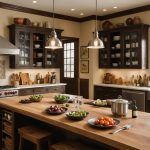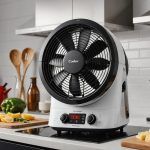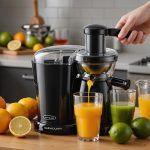Equipping your kitchen with the right range hood is crucial, as it can significantly enhance your cooking experience. The prime purpose of a range hood is to filter out smoke, heat, and odors that cooking can produce, making your kitchen a more pleasant and healthy place. But with so many models available on the market, choosing the right one for your needs can be a daunting task. This article will guide you on how to choose a range hood that is both powerful and silent.
What to Consider When Choosing a Range Hood?
Before diving into the world of kitchen range hoods, you need to understand some essential factors that will influence your decision. These include the hood size, type, cfm, noise level, and filters.
Additional reading : How to Select the Best Meat Grinder for Home-made Sausages?
Size
The size of the hood should correspond to the size of the cooktop. Usually, you want the hood to cover the entire cooktop to ensure it effectively catches all the smoke, steam, and grease. For instance, if you have a 30-inch stove, go for a 30-inch range hood.
Type
There are several types of hoods you can choose from, including wall mount, island, cabinet mount, and under-cabinet hoods. Wall mount hoods are attached to the wall and vent through ducts, while island hoods are mounted to the ceiling and vent above the island. Cabinet mount and under-cabinet hoods are fitted under your kitchen cabinets. Your kitchen layout will determine the type of hood that will suit you best.
Also to discover : Unlocking the perfect lobster feast: your ultimate guide to choosing the right stock pot size
CFM
CFM (cubic feet per minute) refers to the amount of air a range hood can remove per minute. A higher CFM means stronger suction power and better smoke extraction. You want a hood with sufficient CFM to handle the heat and smoke produced by your cooking.
Noise Level
The last thing you want is a range hood that’s too noisy for your comfort. Although powerful hoods tend to be louder, it’s possible to find models that balance power and quietness. Too much noise can ruin your cooking experience or even your conversation in the kitchen.
Filters
Range hoods usually come with either charcoal or metal filters. Metal filters are reusable and are often dishwasher-safe, making them easy to clean. Charcoal filters, on the other hand, should be replaced periodically.
Understand the Ventilation Types
Understanding the ventilation types is important when choosing a range hood. There are two primary types of ventilation – ducted and ductless.
A ducted hood vents the air outside the house, making it more effective at eliminating smoke and odors. However, installing ducted hoods can be complicated and expensive, requiring professional help.
Ductless hoods, on the other hand, recirculate the air within the kitchen after filtering it. They’re easier to install and more flexible in terms of placement. However, they might not be the best option if you do a lot of heavy cooking since they’re less efficient at eliminating intense smoke and odors.
How Much Power do You Need?
When it comes to power, you need to consider two factors: the size of your cooktop and the type of cooking you usually do. If you have a large cooktop or if you often cook at high heat levels, you’ll need a more powerful hood.
The rule of thumb is to have a minimum of 100 CFM for every 12 inches of cooktop width. Therefore, for a 36-inch cooktop, you should aim for a range hood with at least 300 CFM.
However, if you often deep-fry or stir-fry, you should consider a more powerful hood, even if your cooktop is smaller. High-heat cooking methods produce a lot of smoke and grease, requiring a higher CFM to effectively capture and vent these byproducts.
Balancing Power and Noise
While it’s important to have a powerful range hood, it’s equally critical to ensure it operates quietly. A loud, noisy hood can be quite annoying and disruptive.
When shopping, pay attention to the hood’s sones rating. This is a measure of noise level, with one sone being roughly equivalent to the sound of a quiet refrigerator. A rating of three sones is considered moderate, while anything above seven is fairly loud.
Do note that the noise level is dependent on the fan speed. Range hoods usually have several fan speeds, and the noise level increases as the speed goes up. So, while a hood may be quiet at low speed, it might get louder at high speed.
Additional Features for Convenience
Modern range hoods come with several additional features like auto cleaning, blower speed settings, built-in lights, indicator alerts for filter cleaning, and heat sensors. These features add to the convenience and efficiency of the hood, making your kitchen tasks smoother.
Remember, though, that these additional features might add to the cost of the hood. Therefore, weigh your needs against your budget and go for a hood that offers the best value.
Selecting a range hood is an important decision that will impact your cooking experience. It’s not just about choosing one that matches your kitchen décor but one that will efficiently vent out smoke and odors while maintaining a peaceful and quiet environment. So, take your time, do your research, and choose wisely.
Installing Your Range Hood
Installing your range hood is an equally important step as choosing the right one. The way your range hood is installed can greatly impact its efficiency and performance.
When it comes to installing your range hood, you have two main options: DIY installation or professional installation. If you’re a seasoned DIY enthusiast with a good grasp of electrical work and machinery, you may be tempted to install the range hood yourself. However, keep in mind that installing a range hood, especially a ducted one, can be quite complex. It involves setting up the venting system, securing the hood to the wall or ceiling, and hooking it up to the power supply.
Ducted hoods, in particular, require a vent duct. The duct needs to be routed through the walls or ceiling to reach the outside of your house. This can involve drilling holes and fitting pipes, which can be a daunting task if you’re not familiar with it. Moreover, improper installation can lead to poor performance and even safety risks, so it’s crucial to get it right.
On the other hand, professional installation guarantees that your range hood will be installed correctly and safely. The professionals have the necessary skills and experience to handle all types of installations, whether it’s wall mount, cabinet range, island range, or under-cabinet hoods. They also have the right tools and equipment to ensure a smooth and efficient installation process.
As for the cost, professional installation can be more expensive upfront, but it can save you money in the long run by ensuring your range hood works optimally and lasts longer. So, if you’re not confident about installing the hood yourself, it’s best to hire professionals.
Maintaining Your Range Hood
To ensure your range hood continues to function efficiently, it’s important to maintain it properly. This primarily involves cleaning the filters and the hood itself.
Regardless of whether you have a metal or charcoal filter, cleaning it regularly is vital. For metal filters, you can usually remove them and wash them in soapy water or the dishwasher. For charcoal filters, they need to be replaced every few months, depending on how often you cook.
In addition to the filters, you should also clean the exterior of the hood. Use a soft cloth and a gentle cleaning solution to wipe down the stainless steel or other surface materials. This will keep your range hood looking its best and prevent grease and grime from building up.
Some modern range hoods also come with an auto cleaning function. This feature allows the hood to clean itself periodically, saving you time and effort. But whether your hood has this feature or not, regular cleaning and maintenance are key to guaranteeing its longevity and efficiency.
Conclusion
Equipping your kitchen with the right range hood can significantly enhance your cooking experience. A good range hood will not only effectively vent out smoke, heat and odors, but also operate quietly, ensuring a pleasant and peaceful cooking environment. However, selecting the perfect range hood requires careful consideration of various factors including size, type, CFM, noise level, ventilation type, power needs and additional features.
Furthermore, it’s important to remember that the installation process plays a crucial role in the performance of your range hood. Whether you’re opting for DIY or professional installation, it’s vital to ensure that the hood is installed correctly and safely.
Lastly, regular maintenance of your range hood, primarily through cleaning and timely filter replacements, will ensure its longevity and efficiency. A well-maintained hood will offer you the best range of services, making your time in the kitchen enjoyable and stress-free. So, take the time to consider these factors, do your research and choose the best range hood that fits your needs and kitchen space. Happy cooking!








